Your Call?
Which of today’s six featured images is the strongest? Please leave a comment and let us know why you made your choice (or your choices if you go with two). I have a clear favorite that I will share with you in the next blog post.
What’s Up?
I had wanted to publish this on Monday morning but ran into a plethora of Word Press problems. Actually, my continuing problems kept getting worse. I quick WhatsApp call to old friend Peter Kes, now living on a farm in remote South Africa in the midst Zebras, Elephants, and extremely poisonous Mambas, resolved the situation. Thanks again, Peter! The long term prognosis is looking good as found a serious problem with the server that was quickly rectified by the hosts.
Many of you are probably aware of the nightmarish, totally embarrassing Firmware Update problems with the Sony a-1. It truly has been a fiasco. Here is a short summary:
1- Several months ago Sony announced Firmware Update 2.00. It was supposed to improve WIFI connectivity (whatever that is??) instead, it wrecked it.
2- It took Sony a while to remove the new Firmware and a while longer to correct the WiFi problems.
3- The next version, v2.01, fixed the WiFi business but many users of the very popular Sony 200-600 G lens reported that the new firmware wrecked their lens. In addition, many folks reported battery life problems with 2.01.
4- Sony finally released v2.02. The problems with the 200-600 were eliminated along with the battery life problems. Formatting a card with a 2.02 a-1 is about 80% faster than it was with previous Firmware versions.
Aware of the problems with the Firmware Updates, I cautioned my a-1 Setup and Info group not to update and advised everyone to stick with v1.32 that was at least functional.
I did just that.
When things calmed down a bit, feeling some allegiance to my a-1 group, I purchased a second a-1 from BAA friend Greg Clarkson for $3800.00 about seven weeks ago. Some time went by, and with some trepidation, I updated that body to 2.01. Everything was fine with my big lenses. The first time that I used that body with my 200-600 G lens the camera acted as if it were on crack. It refused to focus, the image was jumping around in the viewfinder, and a message popped up stating that I was in AF-S (one shot AF) even though I was in AF-C (continuous AF). I removed and re-inserted the battery, and all was fine. None-the-less, I updated to 2.02 on Sunday morning.
I headed down to the lake and as things turned out, I had my best morning since September 19, this images made with v2.01.
Battery life with 2.02 is fine. There are no issues with the 200-600. Bird Face-Eye AF seems to be somewhat improved. And formatting a card takes about two seconds as compared to 10 seconds or more with previous firmwares. But the very best news is a new feature called Focus Recall. Huge thanks to Arash Hazeghi for pointing it out to me as we worked on an update to the Sony a-1 (a9 iii) flight guide. I took what he taught me about programming Preset Focus/Zoom to a single button for flight photography and turned it into what will surely turn out to be a huge game-changer for general bird photography. Imagine, prevent AF system blindness will soon become a faint memory.
The bad news is that it only works with the Sony prime lenses, the 300mm f/2.8, the 40mm f/2.8, and the 600mm f/4.
The a-1 group folks will be hearing from me on the cumbersome updating process detailing all of their options by this Tuesday the latest.
Others might ask, If this Firmware update business is such a hassle, why do you stick with Sony?
1- Light weight.
2- Incredible Bird Face-Eye AF.
3- Simplicity of operation (using my settings).
4- Zebra technology!
5- Incredible image quality with the a-1.
6- Incredible speed with the a9 iii (120 fps with pre-capture).
7- AF performance and the resulting sharpness with the 2X TCs — no other system even makes it to second place
If you doubt me on #7 above, be sure to enlarge each of today’s featured images.
8- The lightweight Sony 300mm f/2.8 GM lens is un-matched in the industry and is a Godsend for older folks with either TC.
Doubt me? Check out images 4, 4A, 5, and 6 below.
|
|
|
For those who did not use my link to purchase their Sony 300mm f/2.8 GM lens, you can order your a copy here for $209.93. Click on the image to enlarge and to be able to read the fine print. |
The BAA Sony 300mm f/2.8 Lens Guide
Impressed by my (or Pat’s) Sony FE 300mm f/2.8 GM OSS Lens (Sony E) images? Use either my Bedfords or B&H affiliate link to purchase your Sony 300mm f/2.8 GM lens and shoot me your receipt via e-mail and request a copy of the first-ever BAA Lens Guide. I thought that it would take only minutes to create this guide, but I was dead wrong. In the process of creating it, I learned a ton about the lens. And even better, I discovered a simple yet potentially fatal flaw that was resulting in sporadically unsharp flight images. The set-up fix is simple. Just be sure to use one of my affiliate links and get the guide for free.
If not, you can purchase a copy here for $209.93. Yes, it never hurts to use my links and it never costs you one penny more. And if you contact me via e-mail before you make a major purchase, I can often save you some money.
|
|
|
This image was created on 13 October 2024 down by the lake near my home at Indian Lake Estates, FL. Working from the driver’s seat of my SUV, I used the BLUBB-supported Sony FE 600mm f/4 GM OSS lens, the Sony FE 2.0x Teleconverter, and The One, the Sony Alpha 1 Mirrorless Digital Camera). The exposure was determined via Zebra technology with ISO on the thumb dial. ISO 1600. 1/320 sec. at f/8 (wide open) in Manual mode. When evaluated in RawDigger, the raw file exposure was determined to be perfect. AWB at 7:53:40 am on a then partly sunny morning. Tracking: (upper) Zone AF-C with Bird Face/Eye detection enabled performed perfectly even at 1200mm. Be sure to click on the image to enjoy a high-res version. Image #1: Great Blue Heron with tiny fish |
Tiny Prey Items
Considering the Great Blue Herons have been seen swallowing five pound fish, large rats, and baby rabbits, it is astounding to see them capturing tiny fish like the one above. I guess part of the trick is that they need to do it often. Compositionally, a square crop was the strongest available.
|
This image was created on 13 October 2024 down by the lake near my home at Indian Lake Estates, FL. Standing near the canal next to the unoccupied, tangerine painted house at the end of Palmetto Drive, I used the Robus RC-5570 Vantage Series 3 Carbon Fiber Tripod/Levered-Clamp FlexShooter Pro-mounted Sony FE 600mm f/4 GM OSS lens, the Sony FE 2.0x Teleconverter, and The One, the Sony Alpha 1 Mirrorless Digital Camera). The exposure was determined via Zebra technology with ISO on the thumb dial. ISO 1250. 1/1250 sec. at f/11(stopped down one stop) in Manual mode. When evaluated in RawDigger, the raw file exposure was determined to be dead-solid perfect. AWB at 8:16:52am on a then partly sunny morning. Tracking: Expand Spot/AF-C with Bird Face/Eye detection enabled performed perfectly even at 1200mm. Be sure to click on the image to enjoy a high-res version. Image #2: Osprey male on perch in (failed) nest tree |
Mr. Regular
Most male Ospreys have at most a very few tiny dark streaks on their upper breasts. This handsome bird, a male, of course, was sitting on a very nice perch above a nest that was destroyed recently by Milton. This morning — Sunday, he was sitting in nearby but a few feet to the right and a few feet below Saturday’s perch. With a NW breeze that I could not feel, the bird felt it and was facing away. So, I stopped down more than a stop and concentrated on over the shoulder look-back poses. Again I was rewarded for driving down to the end of Palmetto Drive. It pays to check the good spots repeatedly.
When working vertically, I will often move the AF point toward the top of the frame so that I do not have to move the lens much when the bird looks either left or right, or at all when it looks right at me. Overall, Bird Face-Eye tracking with a-1 Firmware v2.01 and v2.02 seems to be somewhat better than it was with v1.32.
|
|
|
This image was created on 13 October 2024 down by the lake near my home at Indian Lake Estates, FL. Working from the driver’s seat of my SUV, I used the BLUBB-supported Sony FE 600mm f/4 GM OSS lens, the Sony FE 2.0x Teleconverter, and The One, the Sony Alpha 1 Mirrorless Digital Camera). The exposure was determined via Zebra technology with ISO on the thumb dial. ISO 1600. 1/1250 sec. at f/10 (stopped down 2/3-stop) in Manual mode. When evaluated in RawDigger, the raw file exposure was determined to be dead-solid perfect. AWB at 8:28:51am on a sunny morning. Tracking:Zone AF-C with Bird Face/Eye detection enabled performed perfectly even at 1200mm. Be sure to click on the image to enjoy a high-res version. Image #3: Tricolored Heron non-breeding adult |
Elusive Till Saturday
Both a worn juvenile and an adult Tricolored Heron have been hanging out in the small bay left of the pier here at ILE. They have both been teasing me and I did not come up with a single decent image until this winter adult posed for me on Saturday morning. I had a hard time choosing which one to post so I will likely do a video soon showing my other keepers along with more from the vertical Osprey series — from which Image #1 was chosen for the down-the-lens-barrel stare.
|
|
|
This image was created on 13 October 2024 down by the lake near my home at Indian Lake Estates, FL. Walking on the pier, I used the handheld Sony FE 300mm f/2.8 GM OSS Lens (Sony E) with the Sony FE 2x Teleconverter and The One, the Sony Alpha 1 Mirrorless Digital Camera). The exposure was determined via Zebra technology with ISO on the Thumb Dial. ISO 1600. 1/1000 sec. at f/11 (stopped down one stop) in Manual mode. When evaluated in RawDigger, the raw file brightness was determined to be perfect (ho hum). AWB at 9:02:28am on sunny morning. Tracking (upper right) Zone/AF-C with Bird Face/Eye detection enabled performed to perfection. Be sure to click on the image to enjoy a high-res version. Image #4: Turkey Vulture, bright adult |
The Pier Railing
On many mornings, there are Turkey Vultures lined up on the pier railings. When I (or anyone else) goes for a walk on the pier, they take flight. At times, depending on the wind, there are some good flight chances. On Saturday there were half a dozen on the railings. Four flew as I walked onto the pier. Then there was only one. I employed my very best stalking technique by moving slower than slow, moving each foot perhaps an inch at a time. And I continually whispered sweet nothings to the bird: “Be a good boy. I am not here to hurt you.” All in all, I got very close, perhaps twelve feet or so.
Notice that at such close range I stopped down one full stop for a bit of extra depth of field. I moved the Zone bracket to the upper right of the frame; when the bird looked back to my left, it tracked the eye perfectly and I had the best image of the series.
|
|
Image #4A: An unsharpened 100% crop of the Turkey Vulture’s eyeball |
Astonishing Sharpness
More than a few folks have asked if the Sony 300mm f/2.8 GM with the 2X is as sharp as the bare 600mm f/4 or the 200-600. You tell me! If this image were any sharper I might cut myself looking at it.
|
|
|
This image was created on 13 October 2024 down by the lake near my home at Indian Lake Estates, FL. Walking on the pier, I used the handheld Sony FE 300mm f/2.8 GM OSS Lens (Sony E) and The One, the Sony Alpha 1 Mirrorless Digital Camera). The exposure was determined via Zebra technology with ISO on the Thumb Dial. ISO 1600. 1/3200 sec. at f/5.6 (stopped down two stops) in Manual mode. When evaluated in RawDigger, the raw file brightness was determined to be dead-solid perfect (ho hum). AWB at 9:04:26am on sunny morning. Tracking: Expand Spot/AF-C performed to perfection. Be sure to click on the image to enjoy a high-res version. Image #5: Whirligig Beetles approach |
Oops!
When I first spotted these subjects scooting about on the surface, I looked at them through the lens and saw what looked like silver bellies. I assumed that they were fish. But when I got home and zoomed in, I could see that they were some type of water beetles. After a bit of surfing online, I came up with what is likely the correct identification. I had never seen them before. I saw them first on Sunday morning. They were in the same spot at 6:30pm the day when I went for my early evening walk. And they were in the same spot on Monday morning.
I wanted to call them a school of beetle. Online sources suggest a swarm or a colony. If you have something better than that, please leave a comment. If you click on the photo to enlarge it, you can see two very small fish just above center.
Sony Zebras handled this near-impossible exposure situation with ease.
|
|
|
This image was created on 13 October 2024 down by the lake near my home at Indian Lake Estates, FL. Walking on sand beach to the left of the pier, I used the handheld Sony FE 300mm f/2.8 GM OSS Lens (Sony E) with the Sony FE 2x Teleconverter and The One, the Sony Alpha 1 Mirrorless Digital Camera). The exposure was determined via Zebra technology with ISO on the Thumb Dial. ISO 1250. 1/4000 sec. at f/5.6 wide open) in Manual mode. When evaluated in RawDigger, the raw file brightness was determined to be dead solid perfect (ho hum). AWB at 9:12:59am on sunny morning. Zone/AF-C with Bird Face/Eye detection enabled performed to perfection. Be sure to click on the image to enjoy a high-res version. Image #6: Osprey — female with fish |
Serendipity
After my shirtless pier walk (for Vitamin D), I walked onto the beach to check on two log perches that I had set up. I happened to glance up and saw an Osprey with a fish flying right at me very close to sun angle, I raised the lens, acquired focus, and fired off about three dozen frames. This was my fave.
Note that I had pre-determined the exposure for Osprey as it was the most likely to be encountered subject. Working in manual mode, I would have gone 3 clicks lighter had a male Boat-tailed Grackle flown by or three clicks darker had a Great Egret flown by. Notice that when you learn to adjust the exposure based on the tonality of the subject, no metering is needed.
Typos
With all blog posts, feel free to e-mail or to leave a comment regarding any typos or errors.

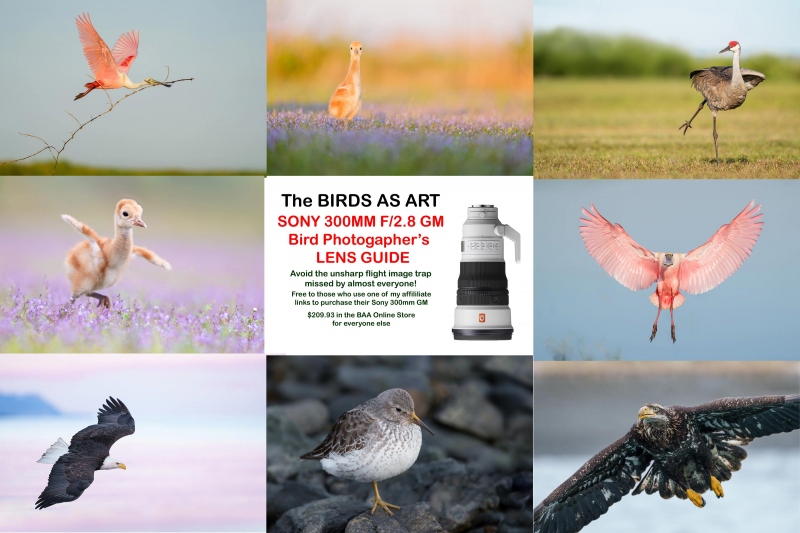
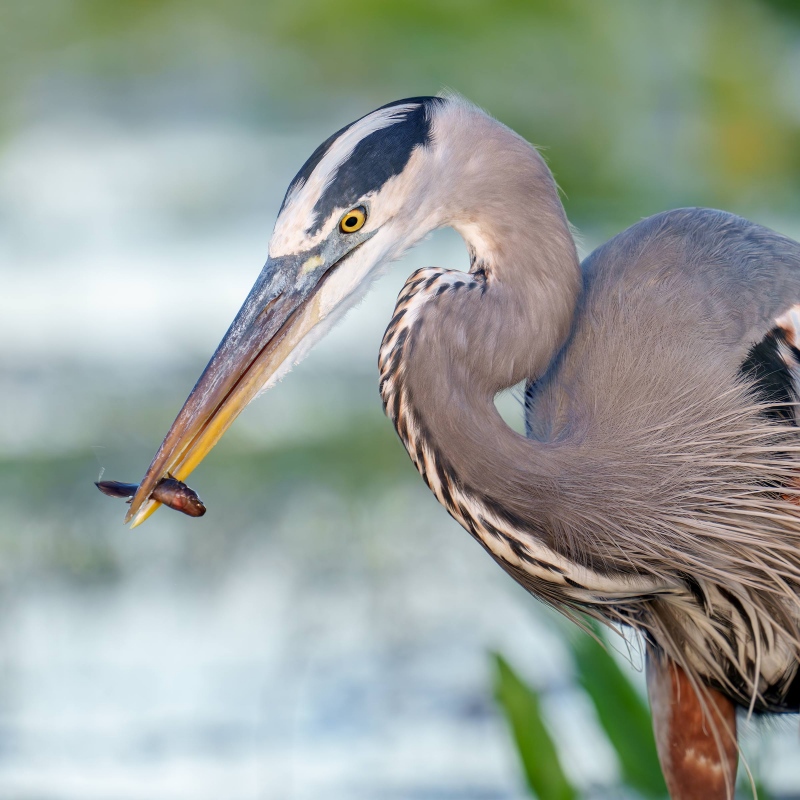
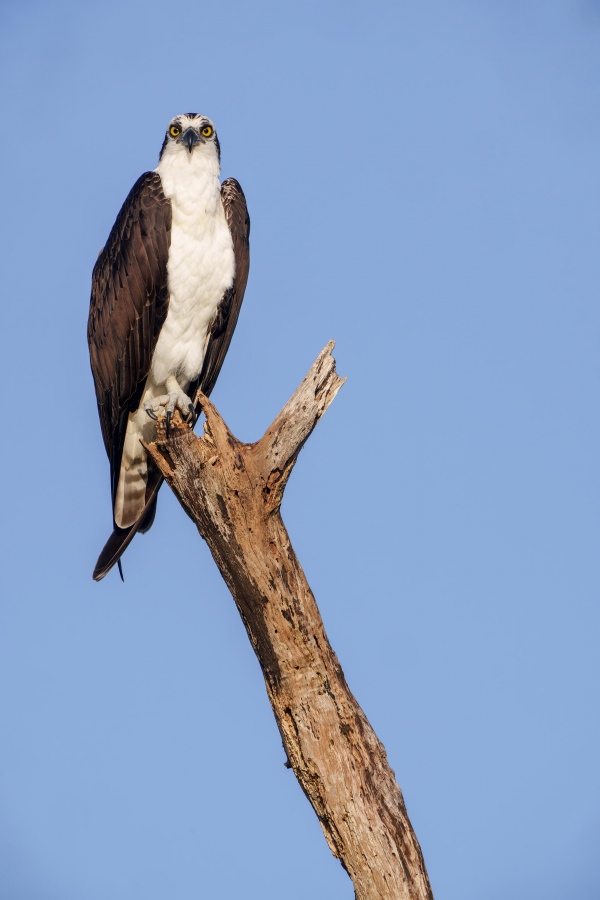
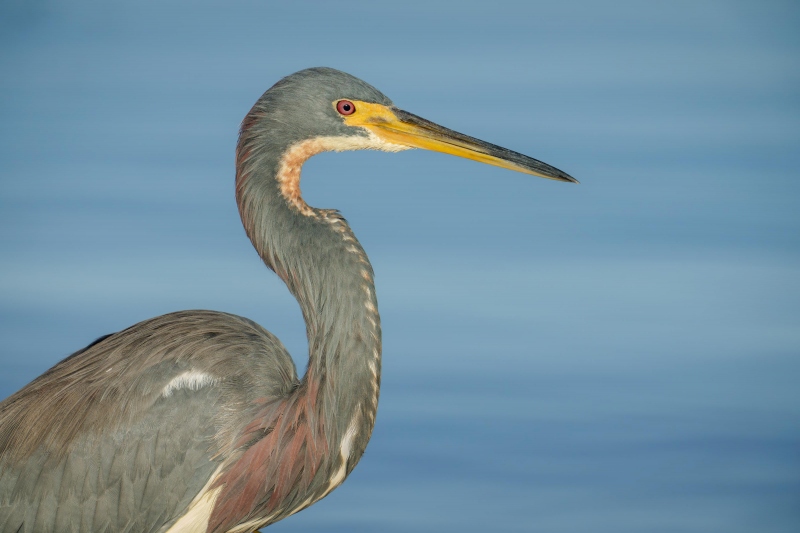
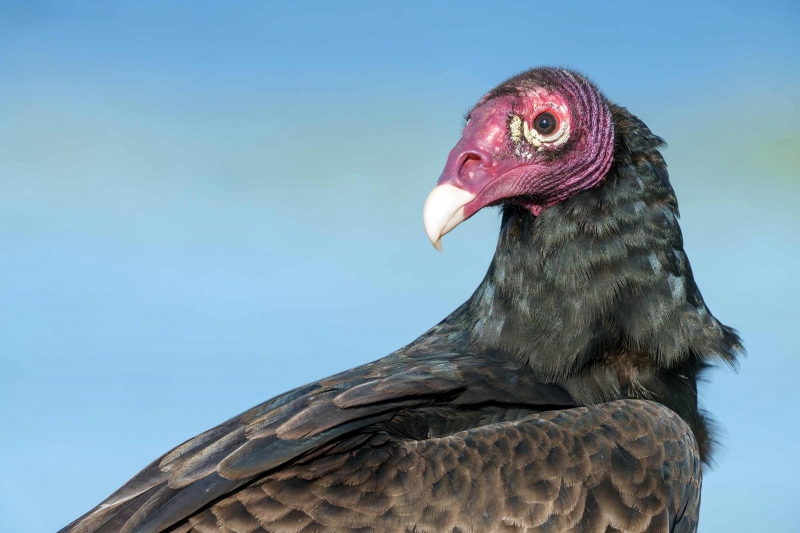
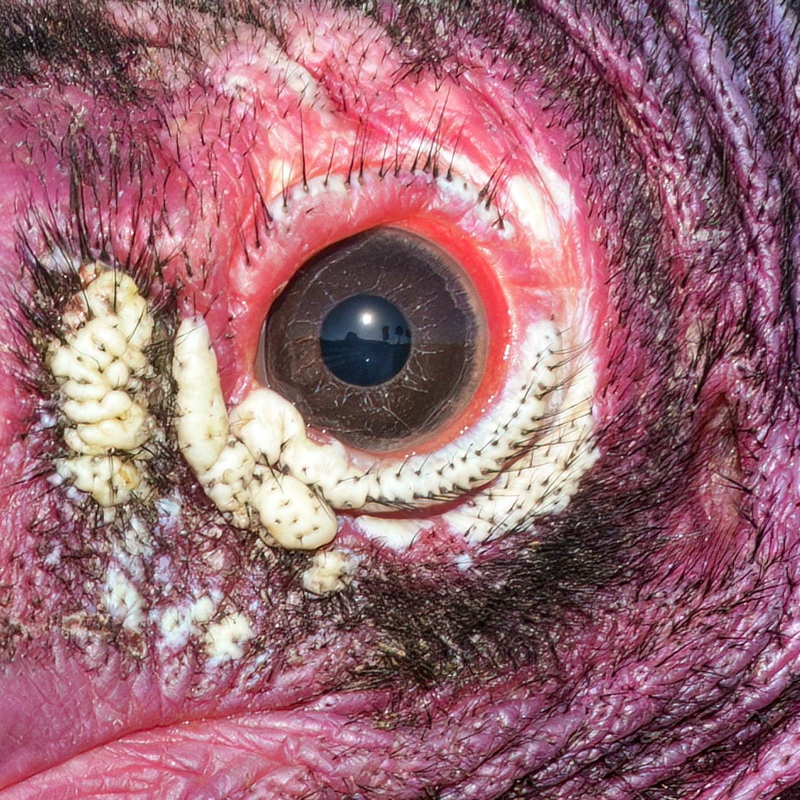
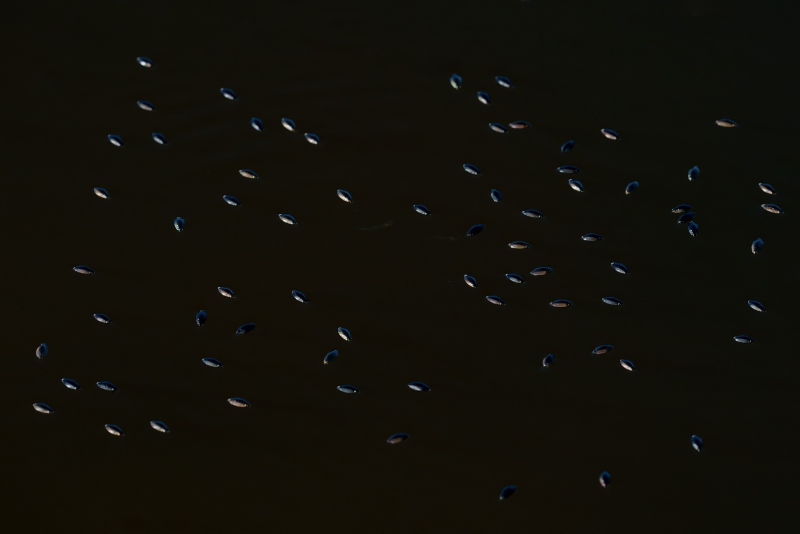
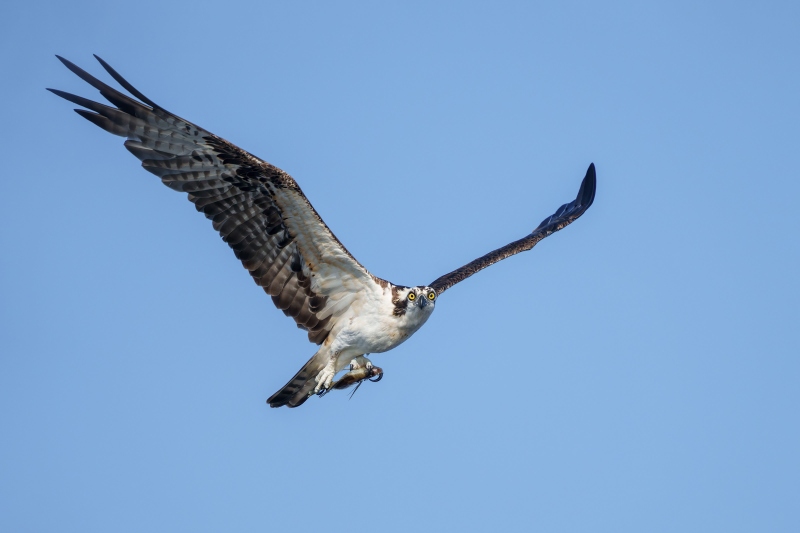













The tricolor portrait I like. Dont see them much
Thanks, Anthony. I hope to be doing a YouTube video with more of the bird soon 🙂
with love, artie
Art:
Honestly, I came up with it myself but realized it wasn’t very original when I read David Policansky’s comment! My favorite is the great blue heron with a small fish, but I was astonished by the vulture’s eyeball! And, like David, I wondered how you knew that was a female osprey.
Hi Pat,
As to the Osprey, there are a few dark streaks in the buffy area of the upper breast. I may have spoken out of turn as some males have a few streaks there ..
with love, artie
Hi, Artie. I hate software upgrades, and tend to stick with old programs that still work as long as I can. The TuVu eyeball is amazing! The TuVu’s head is more purple than I’m used to seeing; the ones I see are more red or even red-orange. My favorite is the GBH with the fish.
How do you know that the osprey is a female?
Hi David,
I too am wary of updates. That’s why I waited two months!!!B. But there are some very good things with v2.02. The purple rear-headed TVs are not common down here but I have actually seen them with even brighter purple on the back of their heads.
See my reply to Pat on the Osprey.
with love, artie